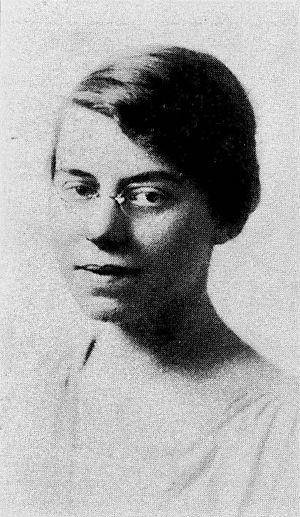Florence Marie Mears facts for kids
Quick facts for kids
Florence Marie Mears
|
|
|---|---|
 |
|
| Born | 18 May 1896 |
| Died | 3 December 1995 |
| Alma mater | |
| Occupation | Mathematician |
| Employer | |
Florence Marie Mears (born May 18, 1896 – died December 3, 1995) was a brilliant professor of Mathematics. She taught at The George Washington University for many years. She was known for being an amazing teacher and a very active mathematician.
Contents
Early Life and Education
Florence Mears was born in Baltimore, Maryland. She went to public schools in Baltimore. She earned her first degree in Mathematics from Goucher College. There, she received a special honor called a Phi Beta Kappa Key.
She continued her studies at Cornell University. In 1924, she earned her master's degree. Her master's paper was about "A Special Function of One Variable." She then earned her doctorate degree from Cornell in 1927. Her doctoral paper was titled "Riesz Summability for Double Series." This important work was published in 1928. Her advisor was Wallie Abraham Hurwitz.
A Career in Mathematics
Florence Mears started her teaching career at the Women’s College of Alabama. Soon after, she became an associate professor of mathematics. This was at Pennsylvania State College. In 1929, she joined The George Washington University.
Teaching at George Washington University
At George Washington University, Professor Mears was very popular. Both her students and other professors liked her. The university's President even called her "one of the greatest teachers of mathematics in the entire country."
When she first started at GW, Mears was an assistant professor. She worked in the Columbian College of Arts and Sciences. Her office was right on campus. At that time, she was the only woman in the Mathematics department. There were seven other male professors. It was also noted that she was paid much less than her male colleagues.
A Master Teacher
Mears was known as a "master teacher." This special title was given to her by the Columbian College of Arts and Sciences. She earned it because of her excellent teaching skills. She also made important contributions to research. Her work helped the Mathematics Department grow.
She taught many different math classes. These included Advanced Calculus and Introduction to Analysis. She also taught Introduction to Infinite Series. Other classes were Fourier Series and Spherical Harmonics.
In 1955, George Washington University honored her. They gave her an Alumni Citation. This was for her twenty-five years of great service. In 1958, the University of California chose her for a special project. She was one of ten women mathematicians. They worked together to study creativity.
In 1962, she joined an important committee. This group chose doctoral papers in mathematics. These papers were for the University of Allahabad in India.
Her Work on Infinite Series
Professor Mears focused on understanding "infinite series." An infinite series is a never-ending list of numbers. Each number in the list follows a certain pattern. For example, 1 + ½ + ¼ + ... is an infinite series. The sum of this specific series is 2.
Mears created several important theorems about these series. A theorem is a proven mathematical statement. Her theorems helped many mathematicians, engineers, and scientists. They were useful in fields like chemistry, physics, and astronomy. One of her most famous theorems is called the Norlund Mean. It helps explain how these series work.
Awards and Honors
Florence Mears was part of many professional groups. She was a member of the American Math Society. She also belonged to the American Math Association.
She received many honorary memberships. These included the Washington Academy of Science. She was also a member of Phi Beta Kappa (1927). Other honors were Phi Kappa Phi (1927) and Sigma XI (1924). She also received several fellowships at Cornell University from 1925 to 1927. Mears wrote many articles and book reviews. These were published in top mathematical journals.
Guiding Future Mathematicians
Professor Mears helped two students earn their Ph.D.s. These were Janos Edvard Hanson and Joseph Blum. They both studied at the George Washington University.
Joseph Blum earned his Ph.D. in 1958. His paper was about Banach Spaces Functionals and Matrix Summability Method. Two years later, in 1960, Mears helped Janos Edvard Hanson. Hanson earned his Ph.D. for his paper on Linear Sequence Spaces.
Lasting Impact
In 1965, Mears was named Professor Emerita of Mathematics. A professor emeritus is a special title. It is given to a professor who retires after long and excellent service.
Florence Mears is remembered as one of The George Washington University’s greatest mathematicians. She is also considered one of the finest and most active mathematicians in the United States. She passed away on December 3, 1995.

